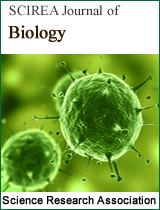Mutation Generated the Mankind
DOI: 349 Downloads 16303 Views
Author(s)
Abstract
On the basis of the mutational theory the process of Homo sapiens birth is investigated. The dependence of intellectual abilities of the man on features of a brain neuron structure in the early period of the man development is investigated. It is shown that Homo sapiens has appeared in result self-supported a temporary mutation of the brain neurons. The mutation has led to occurrence of a plenty of the brain free neurodendrites at early age which are quickly filled by the synaptic communications. This mutation is kept temporarily only in the early period of human life and is supported due to its training by human community. At absence of this mutation support the man does not leave an animal status. On the basis of Hardy - Weinberg law it is shown that at mutational influence on a population there is a disappearance of a mutational influence result for 4 - 5 generations.
Keywords
mutational influence, self-supported mutation, brain, neuron, neurodendrites, synaptic communications, anthropogenesis.
Cite this paper
Andrey N. Volobuev, Eugene S. Petrov, Paul K. Kuznetsov,
Mutation Generated the Mankind
, SCIREA Journal of Biology.
Volume 2, Issue 2, April 2017 | PP. 1-16.
References
| [ 1 ] | E. Libbert. Kompendium der allgemeinen biologie. Rostock. Vierte, durchgesehene Auflage. Fischer Verlag Jena, 1982, 440 p. |
| [ 2 ] | M. Nei. The new mutation theory of phenotypic evolution. PNAS, 104, 30 (2007) 12235 - 12242. |
| [ 3 ] | A.N. Volobuev. Population development of genome in conditions of radiating environment. Moscow, Mathematical Modeling, 17, 7 (2005) 31-38. |
| [ 4 ] | A. Gibbons. The wanderers: Fossils of the first human ancestors to trek out of Africa reveal primitive features and a brutal way of life. Science, 354, 6315 (2016) 958 - 961. |
| [ 5 ] | K.N. Laland, T. Uller, M.W. Feldman, et al. The extended evolutionary synthesis: its structure, assumptions and predictions. Proc. R. Soc. B. 282 (2015) 1019. |
| [ 6 ] | K.N. Laland, B. Matthews, M.W. Feldman. An introduction to niche construction theory. Evol. Ecol. 30, 2 (2016) 191 - 202. |
| [ 7 ] | R. Klein. Archaeology and the evolution of human behavior. Evolutionary Anthropology, 9 (2000) 17 - 36. |
| [ 8 ] | A.N. Volobuev. Bases of medical and biological physics. Samara Publishing House, Moscow, 2011, 672 p. |
| [ 9 ] | D. Hubel, C. Stevens, E. Kandel, et al. The Brain. Mir, Moscow, 1987, 280 p. |
| [ 10 ] | C. Cécile, K. Joshi, J. Coutinho-Budd, et al. Inhibition of SRGAP2 function by its human-specific paralogs induces neoteny during spine maturation. Cell, 149, 4 (2012) 923–935. |
| [ 11 ] | A.R. Rogers, H.C. Harpending. Population growth makes waves in the distribution of pair wise genetic differences. Mol. Biol. Evol. 9 (1992) 552 - 569. |
| [ 12 ] | I.M. Ethell, E.B. Pasquale. Molecular mechanisms of dendritic spine development and remodeling. Progress in Neurobiology, 75, 3 (2005) 161-205. |
| [ 13 ] | C.-C. Chen, J. Lu, Y. Zuo. Spatiotemporal dynamics of dendritic spines in the living brain. Frontiers in Neuroanatomy, 8, 28 (2014) 1 - 7. |
| [ 14 ] | P.H. Gibson. EM study of the number of cortical synapses in the brains of aging people and people with Alzheimer-type dementia. Acta Neuropathologica, 62 (1983) 127 - 133. |
| [ 15 ] | E. Masliah, M. Mallory, L. Hansen. Quantitative synaptic alterations in the human neocortex during normal aging. Neurology, 43 (1993) 192 - 197. |
| [ 16 ] | F. Vogel, A.G. Motulsky. Human Genetics. V. 2. Mir, Moscow, 1990, 380 p. |
| [ 17 ] | F.J. Ayala, J.A. Kiger. Modern Genetics. V. 3. Mir, Moscow, 1988, 336 p. |
| [ 18 ] | S. Wright. Evolution in Mendelian population. Genetics, 19 (1931) 97-159. |
| [ 19 ] | S. Wright. The genetical structure of populations. Ann. Eugen. 15 (1951) 323-324. |
| [ 20 ] | Ching Chun Li. First Course in Population Genetics. Mir, Moscow, 1978, 558 p. |
| [ 21 ] | A.N. Volobuev. Mathematical Genetics. Nova Science Publishers, New York, 2015, 146 p. |
| [ 22 ] | A.N. Volobuev, P.I. Romanchuk, V.K. Malishev. Population and mutagenesis or about Hardy and Weinberg one methodical mistake. Advances in Natural Science, 6, 4 (2013) 55-63. |
| [ 23 ] | A.N. Volobuev, N.O. Zaharova, N.P. Romanchuk, et al. Modern principles of the geriatric analysis in medicine. Advances in Gerontology, 29, 3 (2016) 461-470. |
| [ 24 ] | Mathematical physics. The encyclopedia. Edit. L.D. Faddeev. Green function. Moscow, Big Russian encyclopedia, 1998, 159. |

